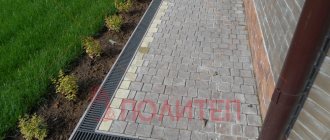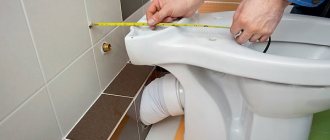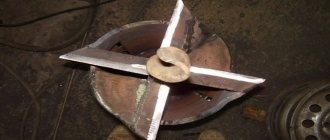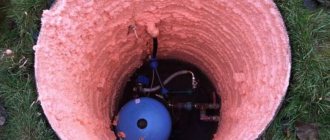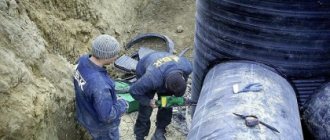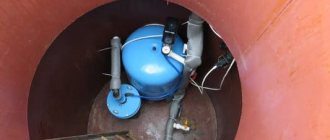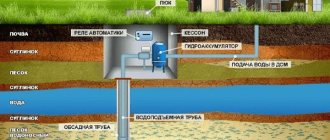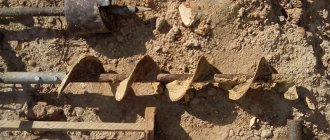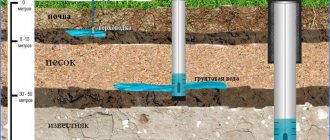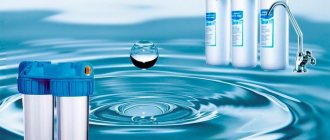A well adapter is a simple and inexpensive device for water supply in a country house. With its help, you can lay a pipe below the freezing depth. An excellent alternative when there is no possibility or desire to install a caisson. Moreover, the adapter has real advantages.
Why choose a water well adapter:
- Does not take up space on the site.
You need a lot of space under the caisson. - Sealed.
Caissons often become leaky and collect water, especially in clayey and/or waterlogged soil. - Automation is installed in the house.
It is necessary to allocate an area for it, but it will be protected from flooding and corrosion. - You can make a water supply system as cheaply as possible
, compared, for example, with a caisson (see below for a comparison of a caisson and a well adapter). - How does a well adapter work?
- Stages of work on constructing a well with an adapter.
- Installation of downhole adapter with photo.
- Visually about the adapter and its installation. Video from the installation from the Zagorod company.
- What is the best way to equip a well with an adapter: do it yourself or trust the professionals?
- Answers to frequently asked questions from customers.
We will tell you in detail about the water adapter for a well. In this article:
Design features of the device
The downhole adapter is a special device. It ensures a hermetically sealed entry of water supply pipes through the casing when installing a non-freezing water supply system. Essentially, the adapter is an angle connector.
The principle of operation of the adapter is that it redirects the water rising up the well shaft into the pipeline leading to the house, which is located below the freezing level of the ground
Although downhole adapters have a fairly simple design, equipping a well with their use is associated with many features. This specificity largely determines the service life of the hydraulic structure.
The main elements of the adapter are the outer and inner parts.
Internal flow part
Externally, this part of the device resembles a tee. One of its sides is blank. It is equipped with technical threads required for joining the two parts of the adapter. The other part is connected to the pipe leading to the deep-well pump. The central branch of the tee-like connection is equipped with the second half of the general connection of the dovetail design.
The reverse side of the holder is equipped with an annular groove intended for a rubber gasket, as well as protrusions for pressing the wedge of the mating part
Its installation is carried out in the hole of the casing pipe, securing it with a union nut equipped with a sealing ring.
Rubber seals are designed to seal the well from the ingress of groundwater. The first seal is placed on the inner surface of the holder plane, the second - between the outer wall and the union nut.
External mate
This is a compact threaded pipe. It is connected to the HDPE pipe and to the discharge pipe of the pump, and is connected to the main part by threading a special rod into the wedge slide. In addition to the wedge, it is equipped with an annular groove and two fittings with internal threads.
The main feature of the device is the strong connection of the external and internal elements, called the “dovetail”.
Thanks to this design solution, a hermetically sealed connection is obtained between the vertical and horizontal sections of the water pipeline with their subsequent removal to the outside through the casing
The intermediate element nipple, which is a single structure with a holder, is intended for connecting the water supply to the pump.
Installation of downhole adapter step by step, photo and description
1. Measurements before installing the adapter for the well, selection of equipment.
This work is performed by the installation company's measuring engineer. First of all, it measures the diameter of the well. The threaded part of the adapter takes up part of the inner diameter. If the diameter of the pipe is small, then the pump with the adapter may not fit in it. The most commonly used pumps are 3” and 4”.
| Pipe diameter | Which pump is suitable? |
| 113 mm, 114 mm | No more than 3" |
| 125 mm | 3” with adapter. |
| 127 mm | 4" with adapter fits flush, it is better to take a 3" pump |
| 133 mm | 4” with adapter |
Important! The surveyor will need a technical passport for the well. It is recommended to find it before installation to save time on measurement.
Determining the diameter of a well during measurement
2. Digging a trench for a water pipe.
They dig a trench 1.5 m deep. This is below the freezing depth for Moscow and St. Petersburg.
Development of a trench for a water supply pipe
3. Drilling a hole in the pipe with a bimetallic crown.
The hole is cut out with a crown with a diameter of 40-44 mm (the diameter of the adapter is taken into account). When drilling, water the nozzle to cool it. It is also important to prevent water from coming into contact with the instrument to avoid short circuits.
If the water level in the well is higher than the insertion depth, then the water is pumped out with a pump. If this does not help, then make a pit and install a more powerful pump in it.
4. Lowering the threaded part of the adapter into the well.
To do this, use an L-shaped rod. You can make it yourself from a polypropylene pipe or from fittings. The threaded part is put on the rod, tied so as not to be dropped, lowered into the pipe and inserted into the drilled hole. From the outside, a gasket and a ferrule are placed on the thread and secured with a nut.
Important! If the pipe is large in diameter, then you can not mount the threaded part separately, but lower and secure the adapter together with the pump (photo below). This will save time.
Adapter assembly, installation option for large borehole diameters
5. Connecting and securing the pump in the well.
A check valve is installed after the pump, and a pipe is connected to it using a fitting. The other end of the pipe from the pump is connected to the wedge part of the adapter.
An automatic drain valve is installed on the pipe behind the pump. It is needed to discharge water so that in winter it does not freeze and burst the pipes. If the pressure in the system is above 0.9 atm, then the valve is closed. If the pressure drops below 0.9 atm, the valve opens and water flows through the hole into the well.
Connecting the pipe to the pump
Drain valve on pipe
Operating principle of the drain valve
Connecting the pipe from the pump to the adapter (installing the adapter assembled with the pump)
For insurance, the pump is tied with a 3 mm stainless steel cable. The maximum immersion depth of the pump is 70 m.
Next, a mounting key is screwed into the wedge part of the adapter. Lower the wedge part with the pump into the pipe and insert it into the already secured threaded part. After this, unscrew the mounting key from the adapter.
Advice. To install the adapter on the well yourself, you will need a T-shaped mounting wrench. You can buy it at a hardware store or make it yourself. To make a key, it is recommended to take a metal pipe and cut a 1” or 1¼” thread on it. Another option is a polypropylene pipe with a diameter of 32 mm, to which a 1” or 1¼” threaded fitting is welded.
Photo of the key for installing the adapter in the well
6. Laying a water supply pipe and connecting it to the adapter.
It is recommended to lay the pipe in the trench in a “snake” pattern so that it does not stretch when the soil moves. The pipe is connected through a coupling, after which the trench is filled with soil.
Photo of attaching a plastic pipe to a well using an adapter
7. Laying the electrical cable from the house.
The cable is pulled into the pipeline trench. A cable with a cross section of 3x1.5 mm is used. To protect the cable in the ground, it is placed in a 20 mm HDPE technical pipe.
Electrical cable and water supply pipe in one trench
8. Installing the well cover, connecting the electrical cable and pump.
The cover has electrical terminals to which the cable from the pump and the cable from the house are connected. Well-known manufacturers of well caps are EMS, WWSystem, Debe.
Connecting the pump and electrical cable in the well cap
Photo of a well with an adapter after completion of work
9. Installation of automation.
A hydraulic accumulator, fine and coarse filters, a pressure switch and a dry running relay are installed in the house. If there is a non-residential technical room, then it is optimal to install automation in it. When designing communications at the zero stage of construction, it is necessary to include a separate boiler room in the project. It will be possible to place not only plumbing equipment, but also heating equipment.
Automation for wells
10. Laying water supply pipes around the house and connecting plumbing.
Tee or manifold wiring is used.
Tee wiring
is optimal when there are few plumbing fixtures in the house, there are few pipes and there is no need to hide them. Tees are installed on the main pipes, from which branches are made to all plumbing points. Polypropylene pipes and fittings are used. For cold water supply, you can use regular pipes. For hot water, only pipes with reinforcement are suitable, since ordinary pipes will stretch at high temperatures. The advantage of tee wiring is its low price. Disadvantages: when one tap is opened, the pressure on all other taps in the house drops. If you need to repair one plumbing fixture, you have to turn off the water supply completely.
Tee pipe distribution around the house
Collector wiring
they are chosen if there are a lot of plumbing fixtures in the house, a lot of pipes and it is desirable to hide them. Pipes made of metal-plastic or cross-linked polyethylene are used. Separate collectors are installed for cold and hot water. Advantages: when opening one tap, the pressure in the others does not drop; you can turn off the water to one tap if repairs are needed. Disadvantages: high price, space required for collectors (taking into account the fact that space is also required for automation), labor-intensive installation.
Manifold piping throughout the house
Water pipes can be connected to the toilet, sink, shower, washing machine and other water consumption points in the house.
Connecting plumbing fixtures to the water supply system
Advantages and disadvantages of “adapter” technology
The technology of constructing a well using an adapter is a worthy alternative to installing a caisson. And the reason for this is a number of undeniable advantages that the downhole adapter has:
- Affordable price . The price of the adapter is many times cheaper than the caisson, thanks to which a wide range of buyers can afford to purchase and install the device on their site.
- Easy to install. It does not require the use of welding equipment or the welding skills of the performer. Excavation work is carried out to a minimum - only along the connected water supply branch. Even a novice master can handle the installation of a downhole adapter.
- High system tightness . The adapter links are adjacent extremely tightly to each other. The sealing ring of the device is quite capable of withstanding a system pressure of 7-8 atmospheres. The design, which provides for disassembling the flow part of the device inside the casing pipe, will ensure the operation of the device even in the presence of a leak.
- High load-bearing capacity. Depending on the thickness of the walls of the device and the material of manufacture, all sections of the adapter thread are able to withstand connected communications and a submersible pump, the total weight of which reaches from 200 to 800 kg.
- Aesthetic qualities . Thanks to the possibility of hidden installation, a well equipped with an adapter will be practically invisible on the site. This is especially true for owners who are afraid of theft of the pump.
Due to the high tightness of the device, it can be safely used when constructing a system in areas with high water typical for the off-season, as well as those located in close proximity to underground communication lines.
Installing an adapter is a win-win option in case of irregular use of the well and “freezing” of the hydraulic structure for a long period
But, like any device, this very useful device is not without its drawbacks. For example, when installing a downhole adapter, it is impossible to provide quick access in case of need for maintenance and repair work.
The tightness of the joining of parts of the downhole adapter can be guaranteed only if preventive treatment of external and internal gaskets is carried out, as well as their timely replacement.
For example, an external gasket in direct contact with the ground becomes unusable after use for 2-3 years. And to carry out this work, you have to dig a pit, which is not always possible.
Installing an adapter limits the possibility of connecting additional sources of water intake from the well, for example, for watering the site
Brass and other metal alloys used in the manufacture of cheap adapters oxidize during use. As a result, parts are often jammed at the joints, which complicates the process of removing the pump.
For this reason, experts advise purchasing adapters made of bronze, stainless steel and specialized “food” alloys. These oxidation-resistant metals will last from 20 to 50 years.
In European countries today only adapters made of food alloys, such as DZR or Sanitary Brass, are used. But domestic GOSTs allow the use of stainless, bronze and brass devices due to the fact that the area of contact of its elements with water is negligible.
Another vulnerable point is the connection of the adapter with the drainage pipe and hose on which the pump is installed.
The key reason for the possible depressurization of structural connections is that the connecting elements are made of different materials
The connecting elements of the system react differently to the effects of temperature and moisture, and also have different periods of wear and aging. Therefore, experts advise, if possible, the pipe leading from the well to the house should be made of stainless steel.
Well construction using an adapter
It is recognized as the best option for buildings on suburban areas with permanent residence. Laying communications deeper than the soil freezing line allows you to maintain the functionality of equipment at subzero temperatures. To accommodate elements of the water intake system that are sensitive to low temperatures, it is recommended to use a separate room inside a residential building, located on the ground floor or in the underground.
A well adapter is a device identical to a plumbing adapter that ensures the tightness of the connection between the casing and the main pipeline. The product is installed inside the shaft at a distance of approximately 2 m from the surface. This arrangement facilitates access to the pit shaft and pumps, simplifying repair and maintenance of mechanisms.
Reviews of the Baker adapter with a diameter of 1 inch
The Baker downhole adapter is chosen by consumers today for many reasons, among others, the protection of the mine from freezing and groundwater ingress should be highlighted. Buyers especially emphasize that such adapters are cheaper compared to a caisson. Prices differ by several orders of magnitude. Installing this equipment is quite simple, which also distinguishes the element from the construction of a caisson.
This well adapter, which has the most positive reviews, can be installed even if the homeowner has minimal knowledge in installation work and plumbing. As for the caisson, it is quite difficult to install it, because you need to be familiar with the technologies of drainage work, waterproofing and concreting.
The described borehole adapter (1 inch) can be purchased at a price of 4,500 rubles. Consumers like that the suction pipe from a water supply station can be used in conjunction with this device if water is drawn from a well whose depth does not exceed 8 m.
Manufacturers
When choosing an adapter for a well, you need to pay attention to the manufacturer, since the performance of the mechanism depends on it. It is worth considering the most popular manufacturers of downhole adapters.
- Debe Pumpar manufactures adapters that meet the pan-European quality standard. Such mechanisms have a housing that resists rust for quite a long time, and can also be equipped with thermal protection, thanks to which the adapter can be installed above the soil freezing level.
- Baker manufactures stainless steel well adapters that are primarily used for potable water piping systems. This mechanism is considered high quality, which allows the use of fittings for home water structures.
- Vinkell produces high quality bronze products. The smallest pipe diameter to which the adapter can be connected is 12 cm. The option of installation is provided next to the sewer system or inside the foundation.
What tools will you need?
To carry out excavation and installation work yourself, you will need a set of tools:
- bayonet shovel;
- scrap (if there is rock or gravel soil);
- yardstick;
- extension cable;
- electric drill with a core cutter;
- grinder (grinder);
- gas adjustable wrench;
Auxiliary materials required for work:
- sandpaper;
- water-repellent sealant;
- tightening clamps;
- connecting fittings.
